Karuta
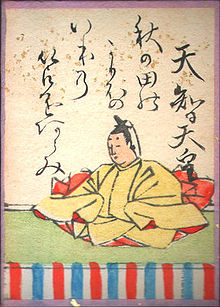
Ogura Hyakunin Isshu karuta
Karuta (かるた, from Portuguese carta ["card"]) are Japanese playing cards. Playing cards were introduced to Japan by the Portuguese traders during the mid-16th century. These early decks were used for trick-taking games. Karuta packs are divided into two groups, those that are descended from Portuguese cards and those from Eawase. Eawase was originally played with shells but were converted to card format during the early 17th-century.
The basic idea of any Eawase karuta game is to be able to quickly determine which card out of an array of cards is required and then to grab the card before it is grabbed by an opponent. There are various types of cards which can be used to play karuta. It is also possible to play this game using two standard decks of playing cards.
The two types of Eawase karuta decks that are most often seen are the "uta-garuta" and "iroha-karuta". In "uta-garuta", players try to find the last two lines of a waka given the first three lines. It is often possible to identify a poem by its first one or two syllables. The poems for this game are taken from the Ogura Hyakunin Isshu and are traditionally played on New Year's Day.
Anyone who can read hiragana can play "iroha-karuta" (いろはかるた). In this type, a typical torifuda features a drawing with a kana at one corner of the card. Its corresponding yomifuda features a proverb connected to the picture with the first syllable being the kana displayed on the torifuda. Karuta is often played by children at elementary school and junior high-school level during class, as an educational exercise. Although several kinds of Karuta games are described below, in reality any kind of information that can be represented in card form can be used including shapes, colours, words in English, small pictures and the like.
Portuguese-derived Karuta
Komatsufuda
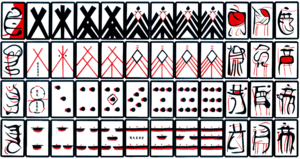
Komatsufuda set.
The first indigenous Japanese deck was the Tenshō karuta named after the Tenshō period (1573-1592). It was a 48 card deck with the 10s missing like Portuguese decks from that period. It kept the four Latin suits of cups, coins, clubs, and swords along with the three face cards of female knave, knight, and king. In 1633, the Tokugawa shogunate banned these cards, forcing Japanese manufacturers to radically redesign their cards. As a result of Japan's isolationist Sakoku policy, karuta would develop separately from the rest of the world. In order to hide the proscription of Portuguese derived cards, makers turned the cards into very abstract designs known as mekuri karuta. By the mid-20th century, all mekuri karuta fell into oblivion with the exception of Komatsufuda (Japanese: 小松札) which is used to play Kakkuri, a matching game found in Yafune, Fukui prefecture.
Unsun Karuta

Unsun karuta set.
The Unsun karuta (Japanese: うんすんカルタ) deck developed in the late 17th century. It has five suits of 15 ranks each for a total of 75 cards. Six of the ranks were face cards. The Portuguese deck used to have dragons on their aces. The Unsun karuta made the aces and dragons separate cards. The order of the court cards change depending on whether it is the trump suit or not just like in Ombre. The new Guru suit used circular whirls (mitsudomoe) as pips. Unsun Karuta is still used in Hitoyoshi, Kumamoto to play hachinin-meri, a game descended from Guritipau, a relative of Ombre. This game preserves some very archaic features such as inverted ranking for the pip cards in the three round suits. Inverted ranking is a feature found in Madiao, Khanhoo, Tổ tôm, Ganjifa, Tarot, Ombre, and Maw and is believe to have originated in the very earliest card games.
Kabufuda
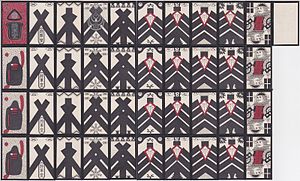
Kabufuda set.
Kabufuda (Japanese: 株札) is another derivative of mekuri karuta but all the suits were made identical. It is used for gambling games such as Oicho-Kabu. They come in decks of 40 cards with designs representing the numbers 1 through 10. There are four cards for each number and the 10 (Jack) is the only face card.
Harifuda and Hikifuda
The gambling game of Tehonbiki can be played with either a Harifuda (張札) or Hikifuda (引札) set. Harifuda contains seven copies of cards numbered one to six in stylized Chinese numerals for a total of 42 cards. The 48-card Hikifuda or Mamefuda (豆札) has eight copies of cards with one to six coins, similar to the coins of a mekuri karuta set. In Tehonbiki, the player tries to guess which number from 1 to 6 the dealer has selected. Some sets may include indicator cards to raise or hedge bets.
Hanafuda
Hanafuda (Japanese: 花札, lit. flower cards, also called Hanakaruta) are 48 card decks with flower designs originating from the early 19th century. Instead of being divided by 4 suits with 12 cards each, a hanafuda deck is divided by 12 suits (months) with 4 cards each. Hanafuda games are mostly fishing games. Their mechanics are derived from Chinese rather than European fishing games.
Eawase Karuta
Uta-garuta
Read main article: Uta-garuta
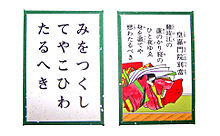
An example of a modern pair of
Uta Garuta cards, where the
torifuda is on the left and the
yomifuda is on the right.
Uta Garuta (Japanese: 歌ガルタ, lit. poem cards) is a card game in which 100 waka poems are written on two sets of cards that make up one full deck of 200 cards. One set is yomifuda (読札) or "reading cards", and the other is torifuda (取り札) or "grabbing cards." As they were denoted, the words in the yomifuda are read and players will have to find its associated torifuda before anybody else does to complete a poem and recite it. The "Ogura Hyakunin Isshu" is the most popular subgenre for the uta garuta called Hyakunin Isshu (Japanese: 百人一首, lit. 100 people, 1 poem). Compiled in the early 13th century by the poet Fujiwara no Teika, this game contains one hundred poems, with each one written by a different famous poet. Competitive karuta is played with uta-garuta cards with competitions on various levels. The Japan national championship tournament is held every January at Omi shrine (a Shinto Shrine) in Ōtsu, Shiga.
Iroha Karuta
Iroha Karuta (Japanese: いろはかるた) is an easier-to-understand matching game for children, similar to Uta-garuta. Representing the 47 syllables of the hiragana syllabary and adds kyo (京, "capital") for the 48th (since the syllable -n ん can never start any word or phrase). A set consists of 48 proverbs each starting with a different syllable and another set of cards expressing a proverb as shown in the picture for a total of 96 cards. There are 3 standard Iroha Karuta variants: Kamigata, Edo and Owari. Each variant has its own set of proverbs based on the local dialect and culture. The Kamigata version is the oldest but the Edo version is the most widespread, being found all over Japan. The Owari variant existed only during the latter half of the 19th-century before being supplanted by the Edo version.
Obake karuta
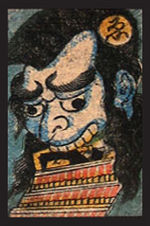
Obake karuta (monster cards), c. early 19th century. Each card features a monster from Japanese mythology and a character from the hiragana syllabary.
Obake karuta is an obsolete variation of Iroha Karuta unique to Tokyo. The cards were created in the Edo period and remained popular through the 1910s or 1920s. Each card in the deck features a hiragana syllable and a creature from Japanese mythology; in fact, obake karuta means ghost cards or monster cards. Success requires knowledge of Japanese mythology and folklore as players attempt to collect cards that match clues read by a referee. The player who accumulates the most cards by the end of the game wins.
Obake karuta is an early example of the common Japanese fascination with classifying monsters and creating new ones. The game is one of the earliest attempts by Japanese companies to categorize legendary creatures, label them, define them, and subsequently market them. As such, it is a precursor to the Godzilla films of the 1950s and later. Even more closely, obake karuta resembles the Yu-Gi-Oh! or Pokémon Trading Card Game, which also involves collecting cards that represent fabulous creatures. In fact, many Pokémon were designed specifically after creatures from Japanese mythology.
In popular culture
The manga and anime series Chihayafuru portrays the story of a group of young people and their journey through the world of karuta.
The video game Tales of Graces features "Magic Carta" as a mini-game. The in-game cards feature characters from every prior game in the Tales series.
Kirby Super Star Ultra has Karuta as a mini-game. It was translated as "Kirby Card Swipe" in the English release.
In episode 303 of the anime series Bleach, they play a game of Karuta with cards based on other Bleach characters.
In episode 12 of the anime series Girlfriend Kari;, Shiina Kokomi's mother presents Iroha karuta cards as a symbol of Japanese New Year. She suggests that they play a game of Iroha karuta, and, although everyone agreed, they are never shown playing.
The Japanese culture and lifestyle television show Begin Japanology aired on NHK World featured a full episode on Karuta in 2010.
In World Trigger (in both the anime (episode 13) and manga) Main Character Mikumo Osamu is seen training his reflexes by playing karuta and ultimately lost to a kid and his capybara.
Read more:
References and notes
- Japanese playing cards of western origin: Portuguese-derived patterns.
- Andy's Playing Cards: Portuguese derived cards: An in-depth look at Portuguese-derived patterns.
- Andy's Playing Cards: Eawase playing cards: Eawase type cards.
- Karuta: Sports or Culture: A detailed essay about the game.
- Karuta at GenkiEnglish: a variation of the game using picture cards.
- Pingmag.jp
- OoishiTengudo/Karuta and Hanafuda: Shop of old standing in Kyoto.
- Discovery Creative Hougen Karuta: Karuta used in the various dialects of Japan.
COMMENTS








 Ogura Hyakunin Isshu karuta
Ogura Hyakunin Isshu karuta Komatsufuda set.
Komatsufuda set. Unsun karuta set.
Unsun karuta set. Kabufuda set.
Kabufuda set. An example of a modern pair of Uta Garuta cards, where the torifuda is on the left and the yomifuda is on the right.
An example of a modern pair of Uta Garuta cards, where the torifuda is on the left and the yomifuda is on the right. Obake karuta (monster cards), c. early 19th century. Each card features a monster from Japanese mythology and a character from the hiragana syllabary.
Obake karuta (monster cards), c. early 19th century. Each card features a monster from Japanese mythology and a character from the hiragana syllabary.